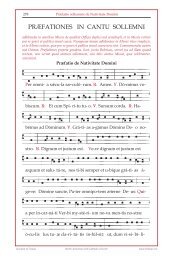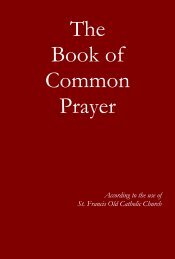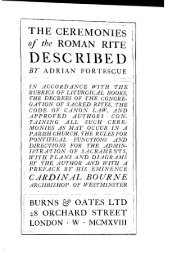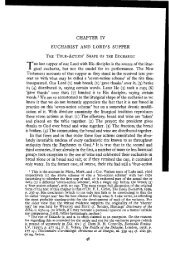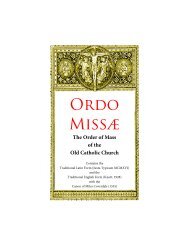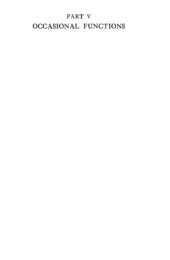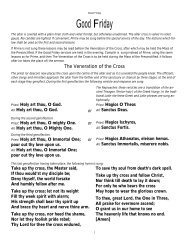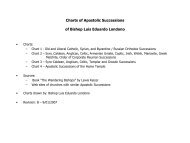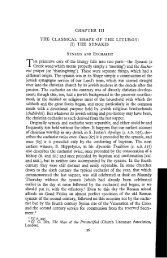Official Record of Apostolic Succession of
Official Record of Apostolic Succession of
Official Record of Apostolic Succession of
You also want an ePaper? Increase the reach of your titles
YUMPU automatically turns print PDFs into web optimized ePapers that Google loves.
On 25 May 1717, five doctors <strong>of</strong> the theological faculty <strong>of</strong> the University <strong>of</strong> Louvain publicly sided with the<br />
Archepiscopal See <strong>of</strong> Utrecht by stating that the Church <strong>of</strong> Utrecht had not been reduced to the status <strong>of</strong> a<br />
mere mission, that the Chapter <strong>of</strong> Utrecht had survived, and that the Vicariate established by + Rovenius<br />
was the ancient Chapter <strong>of</strong> Utrecht. Later, 102 doctors <strong>of</strong> theology at the University <strong>of</strong> Paris, together with<br />
the whole law faculty, publicly agreed with the doctors <strong>of</strong> Louvain. As a result <strong>of</strong> the support <strong>of</strong> the theology<br />
faculties <strong>of</strong> two French universities, three French Bishops (Soanen <strong>of</strong> Senez, Lorraine <strong>of</strong> Bayeux, and<br />
Caumartin <strong>of</strong> Blois) declared that they were ready to ordain priests for the Chapter <strong>of</strong> Utrecht, and actually<br />
did so.<br />
Upon the death, in AD 1710, <strong>of</strong> + Peter Codde, the deposed Archbishop <strong>of</strong> Utrecht, the Cathedral Chapter<br />
(exercising its historically recognized right) elected a successor. No Bishop, however, could be found who<br />
would ignore the Pope's Inhibition by consecrating the Archbishop-elect. The Church <strong>of</strong> Holland continued to<br />
send Her candidates for the priesthood out <strong>of</strong> the country for ordination by foreign Bishops; Her children,<br />
without a diocesan Ordinary, were left unconfirmed. At this point the Jesuits and Rome sought and anxiously<br />
anticipated the total capitulation <strong>of</strong> the autocephalous Dutch Church.<br />
A turning point in the Dutch Church's struggle with Rome came in AD 1719 when + Dominique Maria Varlet,<br />
former missionary priest in The Louisiana Territory in North America, stopped in Amsterdam for a few days<br />
on his way to his new post in Persia. A local Dutch priest, Father Jacob Krys, begged the new Bishop to<br />
confirm 604 orphans and other poor children as an act <strong>of</strong> charity, which he did. He then continued his<br />
journey to Persia, arriving at his residence at Schamake (now Shemakh near Baku in the Republic <strong>of</strong><br />
Azerbaijan) on 9 October 1719. On 26 March 1720, the Bishop <strong>of</strong> Babylon was presented with a formal<br />
Notice <strong>of</strong> Suspension from his <strong>of</strong>fice, sent by the Bishop <strong>of</strong> Ispahan by order <strong>of</strong> the Congregation de<br />
Propaganda Fide, and delivered by a Jesuit priest (Fr. Bachou) because <strong>of</strong> the confirmations in Amsterdam.<br />
Like the late Archbishop Codde, Bishop Varlet elected not to remain in <strong>of</strong>fice while fighting the Papal action.<br />
After careful consideration and prayer, the good Bishop immediately left Persia and returned to Amsterdam,<br />
where he settled permanently.<br />
The Chapter <strong>of</strong> Utrecht had meanwhile repeatedly attempted to get the Pope to allow the election and<br />
consecration <strong>of</strong> an archbishop; Pope Innocent XIII ignored their petitions. The Chapter next turned to the<br />
leading canon lawyers <strong>of</strong> the day. They were told that the Chapter had the canonical right to elect their<br />
archbishop and get him consecrated without the consent <strong>of</strong> the Pope (recent precedents in both France and<br />
Portugal supported this position). Nineteen doctors <strong>of</strong> the theological faculty <strong>of</strong> the Sorbonne (University <strong>of</strong><br />
Paris), and others from Nantes, Rheims, Padua, and Louvain, gave their agreement to this position, as well<br />
as assuring the Chapter that in the case <strong>of</strong> necessity one bishop alone might preside at the consecration.<br />
With the approval <strong>of</strong> the government, the Chapter met at The Hague on 27 April 1723 and, after a Mass <strong>of</strong><br />
The Holy Spirit, elected, with all the canonical forms, Cornelius Steenoven to be Archbishop <strong>of</strong> Utrecht.<br />
Although Fr. Steenoven was elected as the candidate likely to be the least objectionable to Rome, the Pope<br />
refused to answer the Chapter's request to permit his consecration. The Chapter finally begged the Bishop<br />
<strong>of</strong> Babylon to consecrate their candidate. He consented. The government also consented to this the first<br />
consecration <strong>of</strong> an Archbishop <strong>of</strong> Utrecht since the Reformation. Thus at 6:00am on Pentecost XX, 15<br />
October 1724, Cornelius van Steenoven was consecrated in the presence <strong>of</strong> the whole Chapter by the<br />
Bishop <strong>of</strong> Babylon in Amsterdam to be the seventh Archbishop <strong>of</strong> Utrecht and canonical successor <strong>of</strong> St.<br />
Willibrord.<br />
The Bishop <strong>of</strong> Babylon was called upon by The Chapter to consecrate four archbishops for the See <strong>of</strong><br />
Utrecht before his death on 14 May 1742 at The Hague.<br />
OLD CATHOLIC ULTRAJECTINE SUCCESSION I<br />
through Archbishop William Montgomery Brown<br />
Archbishop Gerard Gul (Old Catholic Church <strong>of</strong> Utrecht), assisted by Bishop Johannes Jacobus van Thiel<br />
and Bishop Nicholas Bartholomaeus Petrus Spit (both with The Old Catholic Church <strong>of</strong> Utrecht) and Bishop<br />
Josef Demmel (Old Catholic Church in Germany), consecrated to the Sacred Episcopate:<br />
Archbishop-Primate Arnold Harris Mathew on 28 April 1908 as Archbishop <strong>of</strong> London and Primate <strong>of</strong> the<br />
Old Catholic Church in England. Archbishop Mathew consecrated to the Sacred Episcopate:



